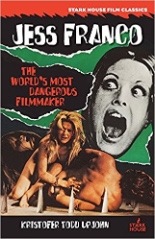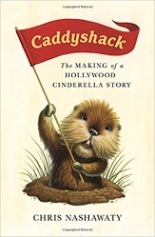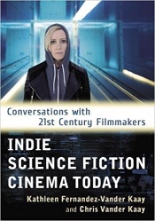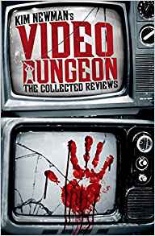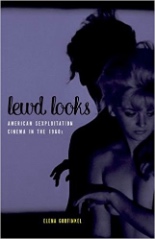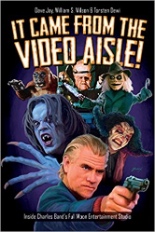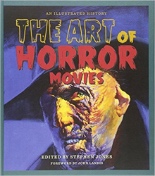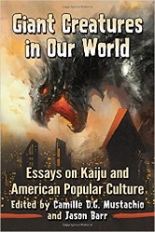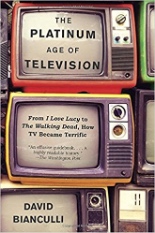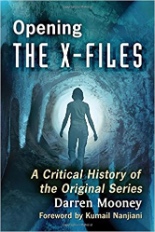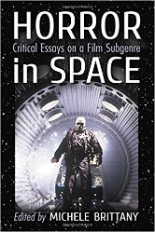 Even if they don’t come along that often, I love a good horror movie set among the stars. I love some bad ones, too. (But not all.) That sent Horror in Space: Critical Essays on a Film Subgenre rocketing toward the top of my reading pile. Edited by Michele Brittany, the McFarland & Company paperback sends 15 think-pieces into orbit, including yet another anatomical reading of Alien. Luckily, other contributors boldly go elsewhere, such as Jason Davis’ rollicking, reverse-order tour through “Aliensploitation” films. Continuing in that vein is Kevin Chabot’s look at slasher sequels that send their killer characters into space, notably Leprechaun 4 and cover boy Jason X. Elsewhere, look for love for John Carpenter, H.P. Lovecraft and the increasingly appreciated Event Horizon.
Even if they don’t come along that often, I love a good horror movie set among the stars. I love some bad ones, too. (But not all.) That sent Horror in Space: Critical Essays on a Film Subgenre rocketing toward the top of my reading pile. Edited by Michele Brittany, the McFarland & Company paperback sends 15 think-pieces into orbit, including yet another anatomical reading of Alien. Luckily, other contributors boldly go elsewhere, such as Jason Davis’ rollicking, reverse-order tour through “Aliensploitation” films. Continuing in that vein is Kevin Chabot’s look at slasher sequels that send their killer characters into space, notably Leprechaun 4 and cover boy Jason X. Elsewhere, look for love for John Carpenter, H.P. Lovecraft and the increasingly appreciated Event Horizon.
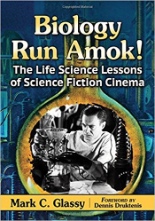 In Biology Run Amok! The Life Science Lessons of Science Fiction Cinema, cancer immunologist and Scary Monsters magazine scribe Mark C. Glassy (an appropriate surname for beaker-laden B-pic fare) examines and reviews the science portrayed in the films, rather than the films themselves. For example, this summation of The Bride of Frankenstein: “The supporting glassware and overall layout of the lab are quite fitting for the work at hand, namely making different reagents, philters, and solutions for the creation of his homunculi.” If that’s your thing, then this experiment may yield positive results for you, with chapters on radiation, re-animation, brain surgery, extreme hair growth, etc. Glassy’s admirable goal here is to teach science through a massively popular art form, which he does with obvious intelligence. While similar to his 2001 book, The Biology of Science Fiction Cinema, also from McFarland & Company, Amok is not the same thing. Consider it a companion — or lab partner, as the case may be.
In Biology Run Amok! The Life Science Lessons of Science Fiction Cinema, cancer immunologist and Scary Monsters magazine scribe Mark C. Glassy (an appropriate surname for beaker-laden B-pic fare) examines and reviews the science portrayed in the films, rather than the films themselves. For example, this summation of The Bride of Frankenstein: “The supporting glassware and overall layout of the lab are quite fitting for the work at hand, namely making different reagents, philters, and solutions for the creation of his homunculi.” If that’s your thing, then this experiment may yield positive results for you, with chapters on radiation, re-animation, brain surgery, extreme hair growth, etc. Glassy’s admirable goal here is to teach science through a massively popular art form, which he does with obvious intelligence. While similar to his 2001 book, The Biology of Science Fiction Cinema, also from McFarland & Company, Amok is not the same thing. Consider it a companion — or lab partner, as the case may be.
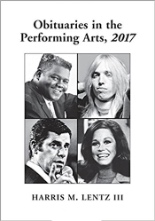 Harris M. Lentz III’s Obituaries in the Performing Arts, 2017 is kind of like having the Academy Awards’ “In Memoriam” segment in book form, but without the varying bursts of applause to let you know that, even in death, it’s all a popularity contest. As if there were any question, the 447-page paperback pays tribute to those actors, actresses, authors, musicians and other artists who left this earth in the last calendar year, from A (Adair, Perry Sheehan) to Z (Zumbrunnen, Eric) — almost 1,300 in all, even including animal stars (orca whale Tilikum) and porn stars (Shyla Stylez). It seems macabre, but such things should be preserved for future generations. That’s what no-frills reference books are for. The nice thing is that, in Lentz’s world, death is an equalizer. By that, I mean that the dearly departed get more or less the same treatment here: a bio and write-up no matter how successful (or un) he or she was. Clifton James, Doris Carey and Frank “The Tank” Miller are as important as Chuck Berry, Mary Tyler Moore and Harry Dean Stanton. Photos are used as often as possible, which is to say for almost every entry. —Rod Lott
Harris M. Lentz III’s Obituaries in the Performing Arts, 2017 is kind of like having the Academy Awards’ “In Memoriam” segment in book form, but without the varying bursts of applause to let you know that, even in death, it’s all a popularity contest. As if there were any question, the 447-page paperback pays tribute to those actors, actresses, authors, musicians and other artists who left this earth in the last calendar year, from A (Adair, Perry Sheehan) to Z (Zumbrunnen, Eric) — almost 1,300 in all, even including animal stars (orca whale Tilikum) and porn stars (Shyla Stylez). It seems macabre, but such things should be preserved for future generations. That’s what no-frills reference books are for. The nice thing is that, in Lentz’s world, death is an equalizer. By that, I mean that the dearly departed get more or less the same treatment here: a bio and write-up no matter how successful (or un) he or she was. Clifton James, Doris Carey and Frank “The Tank” Miller are as important as Chuck Berry, Mary Tyler Moore and Harry Dean Stanton. Photos are used as often as possible, which is to say for almost every entry. —Rod Lott

